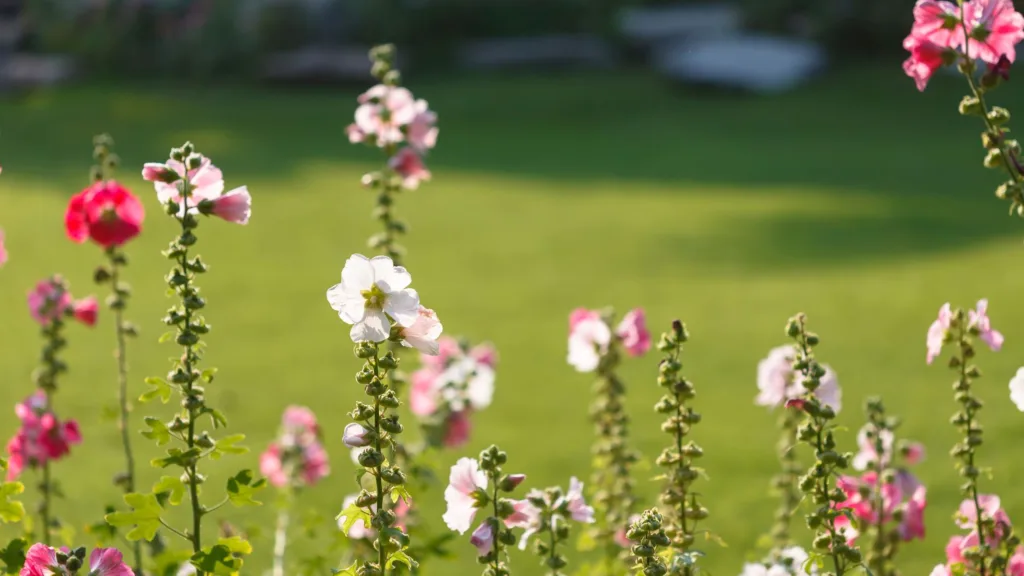Biennial Plant
While annuals offer a quick burst of color and perennials provide lasting charm, biennial plants carve out a unique niche in the gardening world. These fascinating flora take two years to complete their life cycle, offering a distinct set of benefits for your Indian garden.

10 Examples of Biennial Plants
Here are 10 examples of biennial plants:
- Foxglove (Digitalis purpurea): Tall, majestic spikes in shades of purple, pink, and white.
- Hollyhock (Alcea rosea): Towering stalks adorned with large, ruffled flowers in vibrant colors.
- Sweet William (Dianthus barbatus): Clusters of fragrant, clove-scented blooms in a variety of colors.
- Parsley (Petroselinum crispum): Not just for culinary use, parsley’s white flowers attract pollinators.
- Borage (Borago officinalis): Star-shaped, blue flowers with edible leaves and edible flowers.
- Canterbury Bells (Campanula medium): Delicate, bell-shaped flowers in blue, white, and pink.
- Wallflower (Erysimum cheiri): Fragrant, long-lasting blooms in a range of colors, perfect for borders.
- Evening Primrose (Oenothera biennis): Fragrant, cup-shaped flowers that open in the evening.
- Forget-Me-Nots (Myosotis sylvatica): Delicate, sky-blue flowers with a charming name.
- Swiss Chard (Beta vulgaris cicla): While primarily grown for its colorful leaves, Swiss chard also produces attractive white flowers in its second year.
Benefits of Biennial Plant
Biennial plants offer several benefits in a garden or agricultural setting:
- Unique Growth Pattern: Biennials have a two-year life cycle, which can add interest to your garden. In the first year, they grow roots, stems, and foliage but don’t bloom. They bloom, make seeds, and eventually perish in the second year.
- Cold Tolerance: They tend to tolerate cold weather better than annuals, allowing you to enjoy the plant for a longer period.
- Self-Sowing: Many biennials self-sow easily, meaning they can produce seeds that will germinate and grow into new plants without the need for reseeding.
- Attracting Pollinators: Biennial vegetables can attract pollinators in their second year when they flower, which is beneficial for the ecosystem.
- Diversity in Planting: Including biennials in your garden can provide diversity in planting schedules and garden aesthetics over multiple years.
Biennial flowers
Biennial flowers are plants that go through their life cycle in two years. In the first year, they grow leaves and roots, and in the second year, they flower, produce seeds, and then die. Here are some examples of biennial flowers:
- Angelica sylvestris: Known for its purple-stemmed umbels.
- Papaver nudicaule: Commonly called Arctic poppies.
- Dianthus barbatus: Also known as Sweet William.
- Aquilegia: Often referred to as Granny’s bonnets.
- Nicotiana sylvestris: The tobacco plant.
- Digitalis purpurea: Known as Foxgloves.
- Hesperis matrionalis: Sweet rocket.
- Centaurea cyanus: Commonly called Teasels.
- Alcea rosea: Hollyhocks.
- Viola tricolor: Honesty with its translucent seedpods.
Biennial plants names
Here’s a list of biennial plants, which are plants that complete their life cycle in two years:
- Foxgloves (Digitalis)
- Sweet William (Dianthus barbatus)
- Primrose or polyanthus (Primula)
- Forget-me-not (Myosotis)
- Canterbury bells (Campanula)
- Silver dollar or money plant (Lunaria annua)
- Wild angelica (Angelica sylvestris)
- Clary sage (Salvia sclarea)
5 examples of biennial crops
Here are five examples of biennial crops:
- Carrot (Daucus carota) – Typically harvested after one growing season for its edible root.
- Parsley (Petroselinum crispum) – A common herb that completes its life cycle in two years.
- Dill (Anethum graveolens) – Known for its small yellow flowers and used as a herb.
- Leek (Allium ampeloprasum var. porrum) – A member of the onion family, grown for its edible leaves.
- Fennel (Foeniculum vulgare) – Another herbaceous plant that is biennial in nature.
Biennial plants in other languages
Spanish: planta bienal
French: plante bisannuelle
German: zweijährige Pflanze
Italian: pianta biennale
Portuguese: planta bienal
Dutch: tweejarige plant
Russian: двулетнее растение (dvuhletnee rasteniye)
Chinese (Simplified): 两年生植物 (liǎng nián shēng zhíwù)
Japanese: 二年生植物 (ninensei shokubutsu)
Korean: 이년생 식물 (inyeonsaeng sigmul)
Arabic: نبات ثنائي الحول (nabat thunay alhul)
Turkish: iki yıllık bitki
Hindi: द्विवर्षीय पौधा (dvivarshiya paudha)
Greek: διετές φυτό (dietes fyto)
Swedish: tvåårig växt
Polish: roślina dwuletnia


